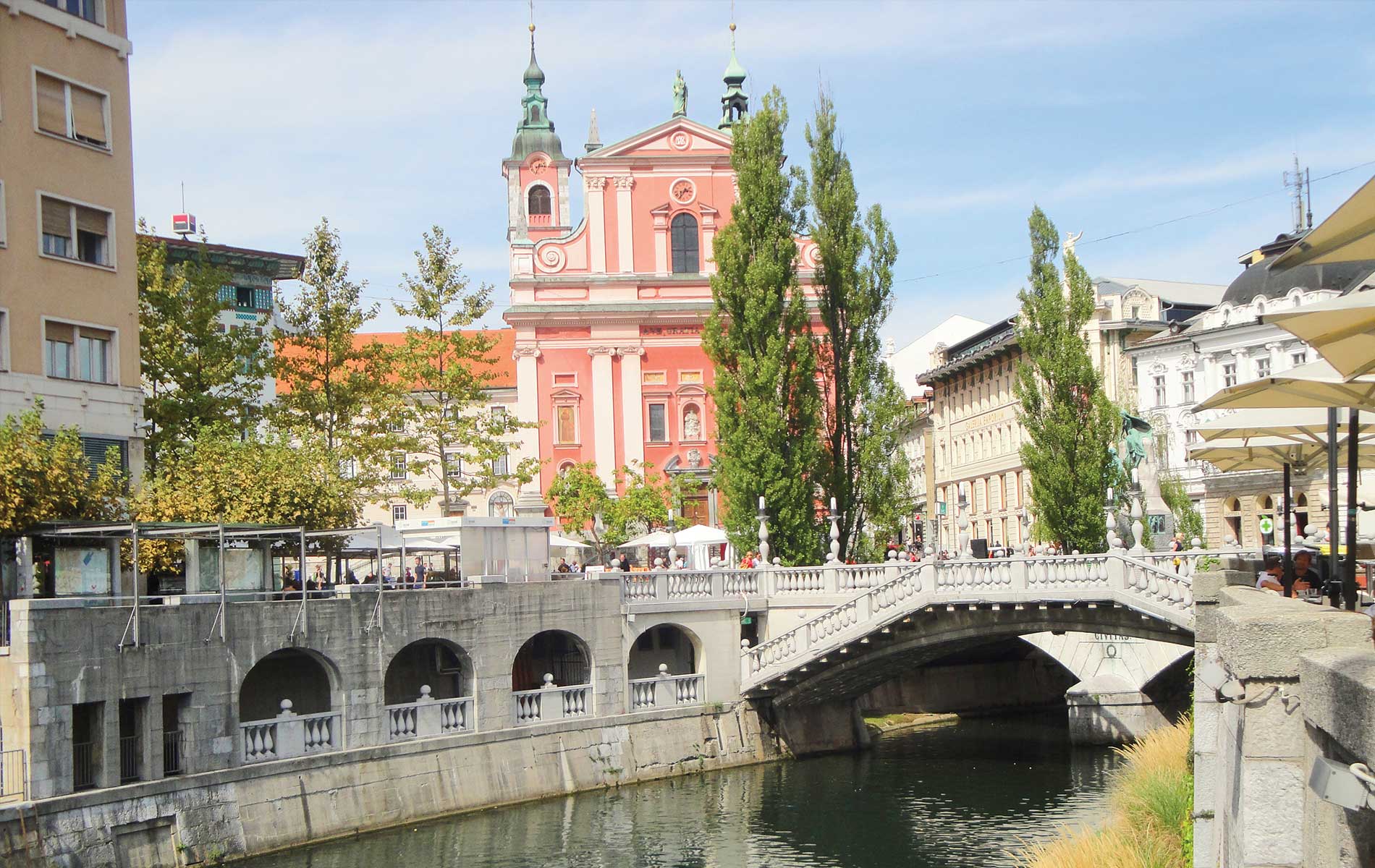
vie-magazine-slovenia
Cycling in Surprising Slovenia
A Taste for Adventure
(A continuation of “A Walk on the Wild Side” published in the November/December 2012 issue of VIE)
By Kim Duke-Layden | Photography by Kim Duke-Layden and John Layden
Surrounded as it is by Italy, Austria, Hungary, and Croatia, pocket-sized Slovenia is an irresistible blend of the best of these cultures. Join my husband, John, and me as we savor a “slow-journ” of this unfamiliar country’s many unexpected pleasures and well-kept secrets.
After a glorious week spent soaking up northwestern Slovenia’s alpine heaven, John and I switched gears and headed to Ljubljana (Lyoob-lyee-AH-nah) for a brief “city break” before starting our weeklong bicycling trip. The late August morning was postcard perfect. As we vamoosed from Lake Bled and veered southeast on the autoroute, the jagged Julian Alps slowly disappeared behind us. Within an hour, we arrived at the quaint Pri Mraku Guesthouse (www.daj-dam.si), conveniently located in the “Land of Frogs and Dragons.”
Ljubljana is Slovenia’s centrally located capital and largest city, despite its modest population of 300,000. Ljubljana is situated on the Ljubljanica River and features an atmospheric Old Town. With a dragon befittingly as its modern-day mascot, Ljubljana has a history deeply steeped in legends and myths. In fact, once upon a time fire-breathing dragons allegedly roamed the swampy countryside devouring innocent people. Some twenty-first century “dragon debunking” theorists attribute the fiery sightings and mysterious disappearances to methane-fueled pyrotechnics, sinkhole-prone limestone soil, and spontaneous combustion. Poof!
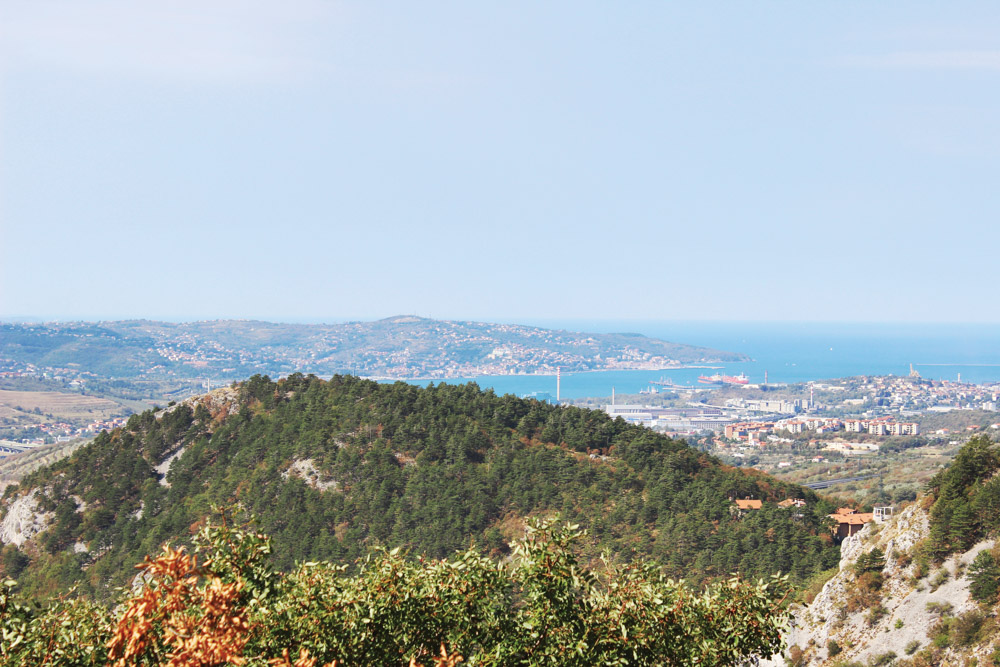
View of Trieste, Italy, and the Adriatic Coast from the Alpe Adria Trail
Lively Ljubljana resembles a miniature Salzburg with a Slavic slant: neoclassical architecture; a medieval castle hovering above winding, cobbled streets; and a lazy river that bisects its city center. Yet, with sixty thousand college students, Ljubljana exudes a younger, edgier vibe. Enticing is its eclectic array of old-world and contemporary cafés, bars, boutiques, and gelato stands that hopscotch endlessly along the riverside promenade, crisscrossing many a most (bridge) and trg (square).
Luckily, our visit coincided with Ljubljana’s end-of-summer festival, a continuous block party stretching along both banks of the willow-fringed river. Savory aromas of grilled sausages and meats filled the air. Promotional kiosks offered free samples of Slovenia’s retro-but-recently-hip-again Cockta drink, which tasted like cherry cola and was originally created as a substitute for Coke during the Iron Curtain era. Under a full moon, international bands played jazz, rock, and classical music. Our favorite group was a yodeling Austrian folk quartet. The festive evening ended on a creamy crescendo—a sladoled (gelato) crawl. Ljubljana’s gelato is renowned for being Slovenia’s best.
When the weather turned chilly and wet, we decelerated and savored our surroundings. During a drizzly walking tour, we strode through centuries of Ljubljana’s history, learning about its most revered citizens: the prolific architect Jože Plečnik and nineteenth-century bad-boy poet France Prešeren. After exploring Ljubljana’s grad (castle), we lingered over steaming bowls of hearty mushroom soup and venison stew at atmospheric Gostilna Sokol (www.gostilna-sokol.com).
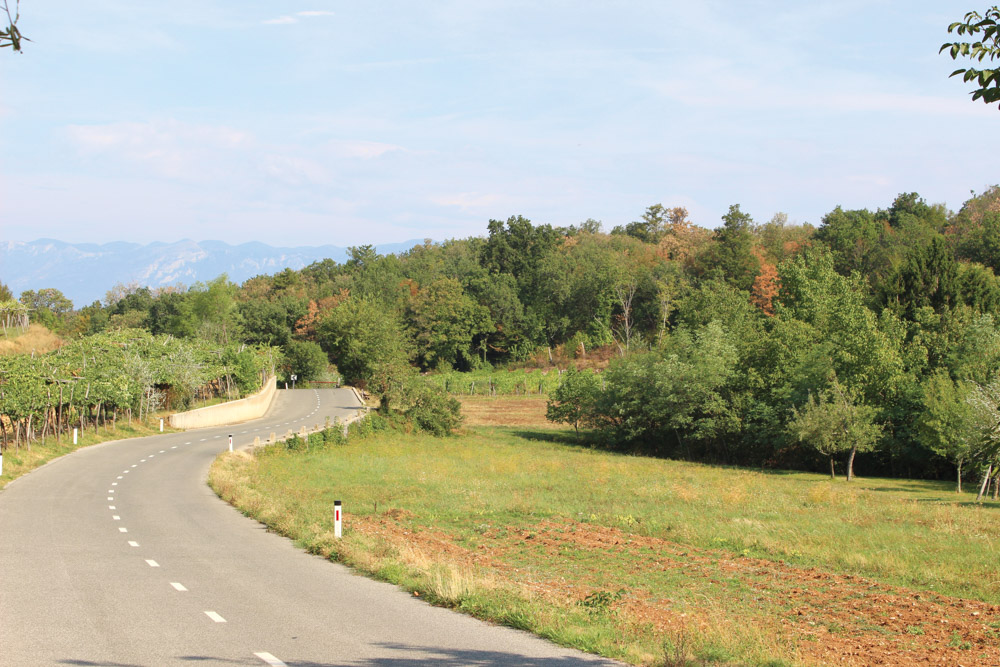
Picturesque countryside near Ljubljana with the Julian Alps in the background
Despite Saturday morning’s soggy conditions, Ljubljana’s riverside market bustled. Food stalls brimmed with unique Slovenian specialties: honey brandy; repas (turnips); groats, a muesli of hulled buckwheat, barley, and corn; and žrebičkov zrezek (horse steak), considered a delicacy. Like many, we noshed on tasty street food washed down with pivo (beer). But for our twelfth wedding anniversary dinner, we splurged at award-winning Špajza (www.facebook.com/spajza-restaurant). Our monkfish risotto in a velvety saffron and champagne sauce, herb-crusted lamb chops, and braised rabbit au jus with capers, olives, and pea puree all tasted superb, as did the red wine from southwestern Slovenia.
On our third day, we transferred to modern Hotel M (www.m-hotel.si/hotel-ljubljana) on Ljubljana’s outskirts, where our Emerald Group Cycling Tour began. Our tour outfitter, Helia Travel Agency (www.cyclingslovenia.com), had also expertly arranged our previous week’s self-guided Julian Alps trek. We chose a guided trip in hopes of making friends with fellow cyclists while exploring Slovenia’s top attractions and off-the-beaten-path hideaways.
During orientation, we met Helia’s charismatic owner, Sašo Skalic, who was standing in as tour leader for a sick employee. The multilingual Sašo transitioned seamlessly between German, Russian, and English, accommodating our group of seven. He joked that many people confuse Slovenia and Slovakia—even their own citizens—and that each year several tons of misaddressed mail are swapped between these former Yugoslavian countries. At age fifty, Sašo said he preferred a relaxed cycling pace, breaking often for kava (coffee), pastries, sightseeing, and leisurely lunches. With raised glasses of Slovene “bubbly,” we toasted to kindred spirits and drier weather!
Day 1: Ljubljana to Vrhnika (Ver-nee-kah) / Distance: 36 miles
At breakfast, we sat with two fellow cyclists: Günther, an engineer who spoke English fluently, and his girlfriend, Martina, an office manager, who both lived in Münster, Germany. When their friends from Berlin—newlyweds Klaus, a recently retired engineer, and Sabine, a scientist— joined our table, Günther became chief translator. Ironically, John and I were the “old married couple,” although we had seen the fewest birthdays of the group.
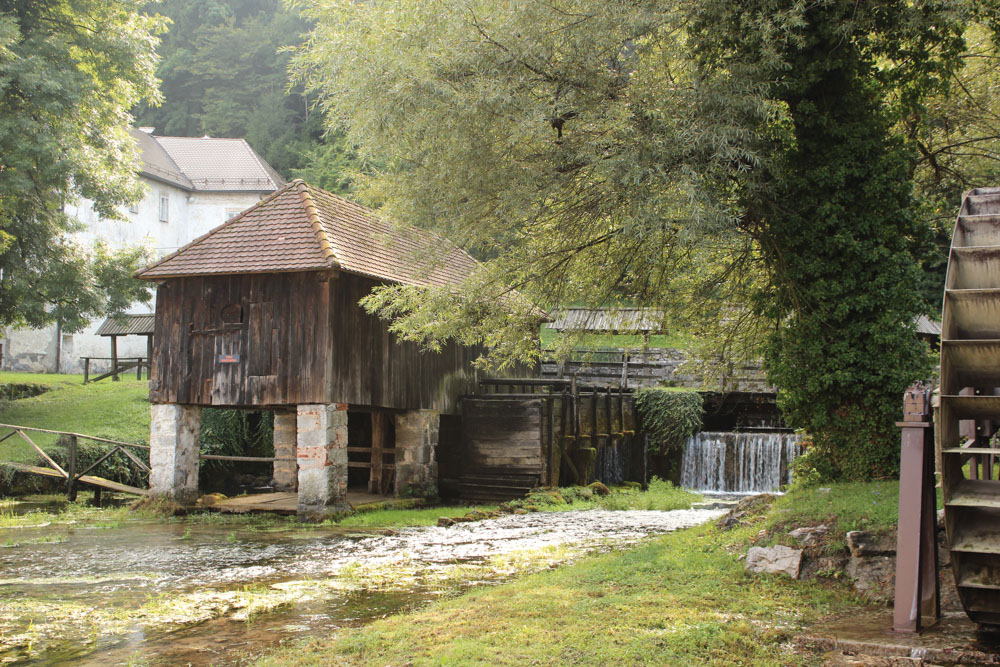
Old mill and former abbey on the grounds of Vrhnika’s industrial museum
Outside Hotel M, ominous clouds hovered while Sašo fitted us with twenty-one-speed bikes and collected our luggage. Driving Helia’s “sag wagon” (support car) was the same petite brunette who had taken us to Triglav’s trailhead after dismantling her trunk and cramming in our luggage. After seeing me, she immediately smiled. Bless her heart! Sašo introduced her as Oksana, his Russian-speaking significant other, who would shadow us most of the trip. With the arrival of Andrea, a married, information systems technology consultant from Moscow who spoke English flawlessly, we set out, pedaling single-file toward Ljubljana’s historic quarter.
Sašo, a natural-born storyteller, entertained us with an interesting city tour sprinkled with historical factoids and amusing asides, providing us greater insight into Ljubljana’s culture. Miles away, the countryside’s vast pastures transitioned into forests dotted with crumbling stone farmhouses, colorful flower boxes, and slowly churning waterwheels on trickling streams.
Surrounded by nature, we ate lunch at a rustic restaurant known for grilled meats. Sašo ordered for us, choosing several huge platters of delicious pork kebabs, cutlets, and sausages served with potatoes, polenta, and ajvar, a piquant eggplant and red bell pepper condiment.
After miles and miles of rural back roads, we stopped at a “technical” museum near Vrhnika. Its former abbey’s grounds featured an old flour mill and picturesque pond, plus numerous Industrial Revolution–themed displays, such as vintage cars and textile making from nettles. Minutes later, we arrived in quaint Vrhnika, where we enjoyed a group dinner and a good night’s rest.
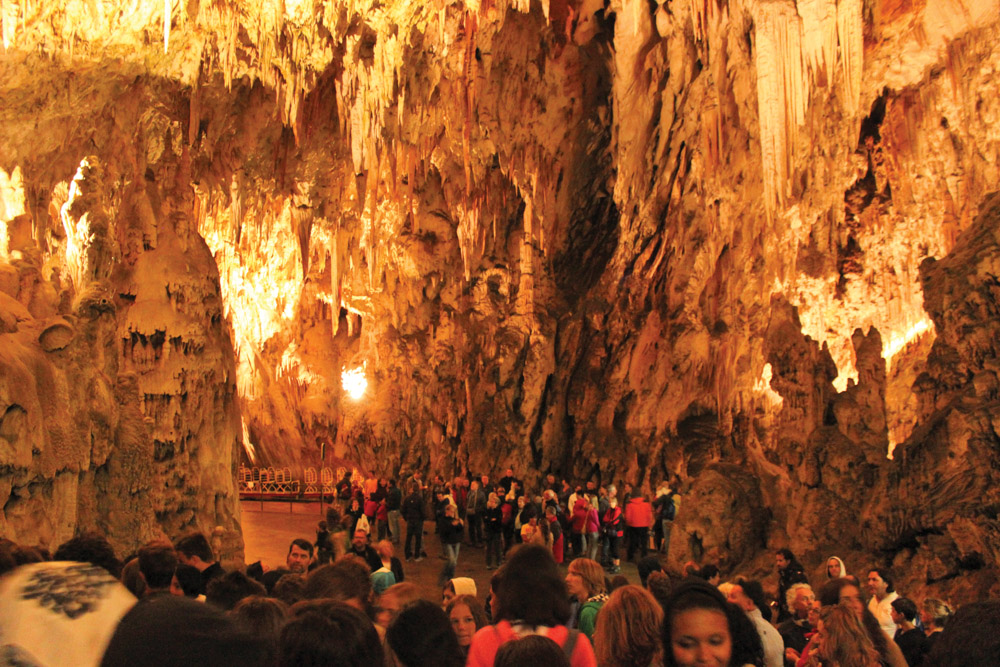
One of many mammoth chambers inside Postojnska Jama
Day 2: Vrhnika to Postojna (Pos-toy-nah) / Distance: 21 miles
My hearty breakfast and the morning fog burned off quickly as we pedaled higher up the steep road that wended around dense woods with plunging overlooks. At a roadside café, we reunited for a midmorning break and reminisced about the trip’s first hellish hill. Grinning, Sašo reiterated that day two’s course was “undulating”; I soon discovered that our definitions of “undulating” differed somewhat.
As I tackled the next big ascent, Sašo asked me why I didn’t shift down to a lower gear. My explanation was simple: “No pain, no gain!” After powering ahead to the top, I blissfully breezed down the other side. As we roller-coastered along, Sašo said Slovenia is Europe’s second most forested country—Norway ranks first. He added that since Slovenia’s government began protecting brown bears decades ago, there are lots of bears in them thar woods! Nowadays, Slovenia controls its bear population by often giving these furry critters as “gifts” to visiting dignitaries and by allowing limited hunting.
Bear hunting licenses cost a whopping $7,800 annually, so many Slovenes eat this delicacy at affordable gostilnas (taverns), which is what we did for lunch. Surprisingly, Portus Gostilna and Pizzeria in the tiny settlement of Unec (Oo-neck) prepared delicious medved (bear) that tasted like tender slices of roast beef. Equally unexpected, tipping isn’t customary in Slovenia. No wonder our servers from the previous week liked us so much!
By midafternoon, we whizzed down the final hill of the day and landed in Postojna, nestled in the verdant knolls of southeastern Slovenia. We quickly checked in to centrally located Hotel Kras (www.Hotel-Kras-Tripzen.com) and then trotted down the steep road for a guided tour of one of Slovenia’s top attractions. Astounding Postojnska Jama (cave) was the largest and coldest cave I had ever visited. Brrrrrrrrr!
Day 3: Postojna to Štanjel (Shtan-yel) / Distance: 34 miles
On a chilly, overcast morning, we rode into the surrounding hills toward Predjama Grad (Cave Castle), Postojna’s other star attraction. My aching legs felt like rubber as I pedaled harder. Then I remembered my recent conversation with Sašo and shifted from the highest gear to the lowest—although I refused to dismount and push the bike.
The payoff was well worth the effort. Ahead, carved dramatically into limestone cliffs, perched jaw-dropping Predjama Grad, whose cave labyrinth extends six miles back to Postojna. Dating from the Middle Ages, the castle had many noble tenants, but the most notorious owner, Erazem, hid out in the impenetrable fortress between pillaging and plundering forays. For me, exploring the intriguing medieval maze of secret passageways, torture chambers, and exhilarating bird’s-eye views was a trip highlight.
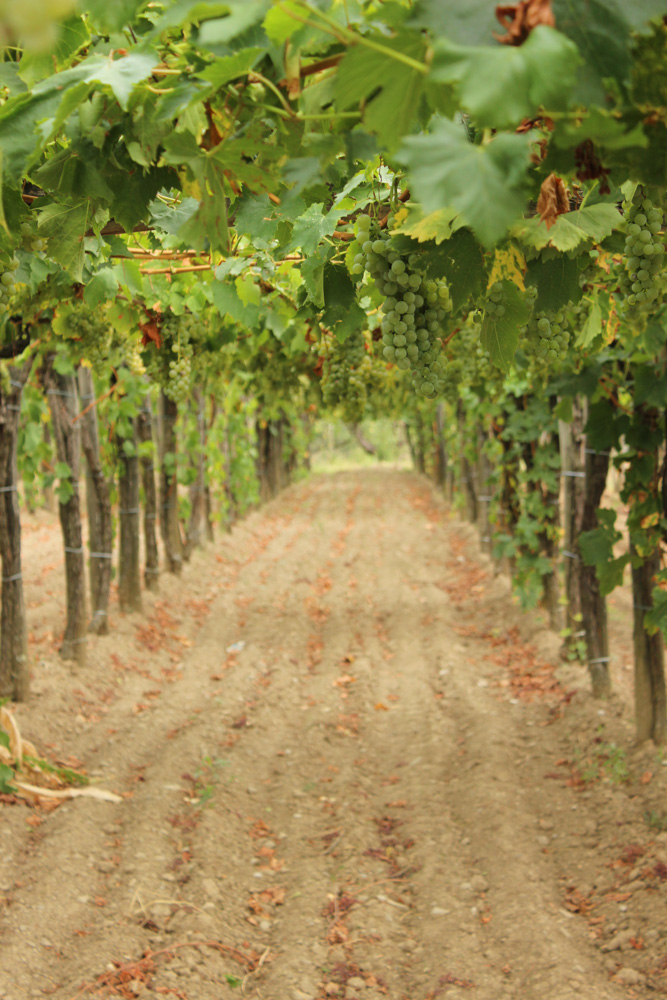
Teran grape vineyards in southwestern Slovenia near Italy’s border
Day three’s route was the most diverse and undulant thus far. We maneuvered up rugged paths bordering fertile farmlands and along stretches of busy highways. Most exhilarating was a white-knuckled descent down a pebbly, pothole-riddled road with an 8 percent grade! Midway down, the asphalt unfurled, gratifying my “need for speed.” Afterward, Oksana rewarded us with a delightful picnic lunch, including wine and homemade cake from Sašo’s mom.
Rested and rejuvenated, we zigzagged near southwestern Slovenia’s Italian border, which is known for its Mediterranean climate and highly acidic Teran, a red wine that tastes best with food. The scrubby, rolling terrain resembled the Texas Hill Country. By 5:00 p.m., we arrived in teeny Hrusevica near tiny Štanjel, where we spent two nights at Grča (Gork-a) Tourizem Kras (www.grca.si), a charming, family-owned inn and winery.
Libations and laughter flowed freely throughout our first night, from happy hour in the hacienda-style courtyard to a private wine tasting with the charming vintner in his cellar, followed by a delicious home-cooked dinner under the stars. The convivial company and camaraderie were icing on the cake!
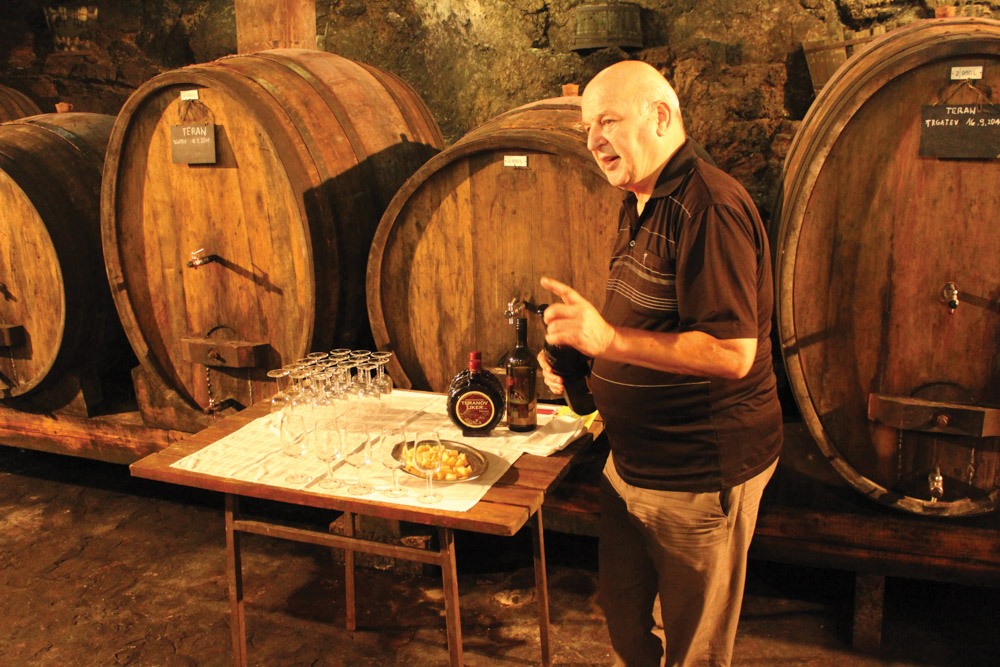
Wine tasting hosted by Grča’s winemaker in his cellar
Day 4: Optional Rest Day / Distance: 7 miles
If we were in Moscow, our breakfast at Grča would have cost several hundred dollars. Andrea told us that a palm-sized portion of prosciutto, or pršut, the Slovene equivalent, would cost around $150! Since Grča produces its own air-cured hams, we enjoyed this delicacy several times during our stay.
Rather than chill out or cycle to neighboring villages, John and I day-tripped to Italy. Following Sašo’s instructions, we biked to Štanjel’s nearby train station, hopped aboard a colorful commuter train, and thirty-five minutes later said “Buon giorno!” to Nuova Gorizia. Opposite the tracks lies the city’s newer, less-charming Slovene half, Nova Gorica, which was separated by border walls until WWII ended.
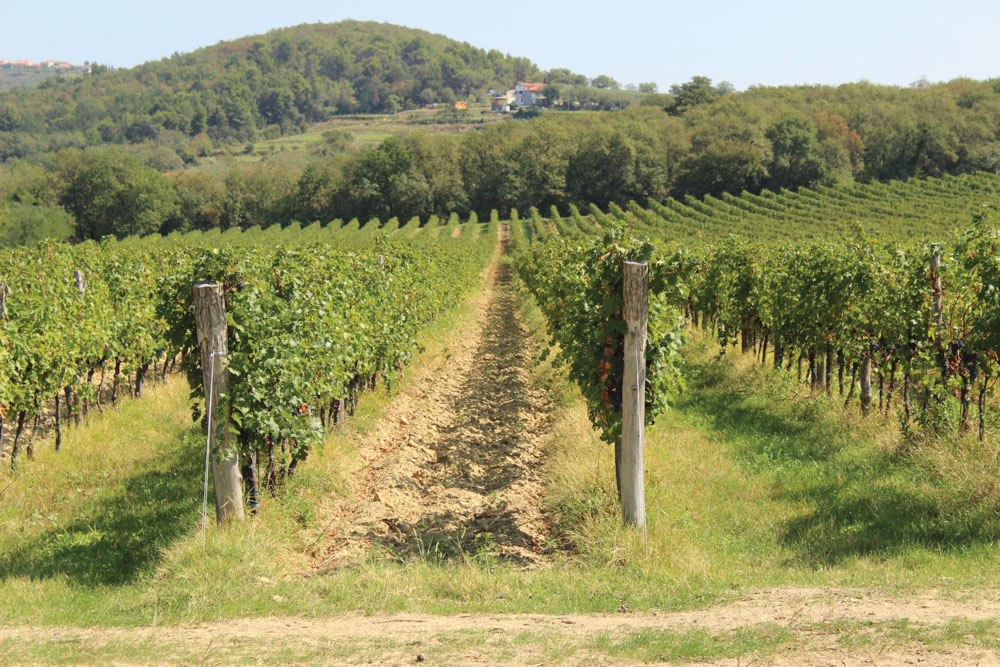
Endless vineyards and olive trees along our final route to Slovenia’s coast
Day 5: Štanjel to Lipica (Lee-pee-za) to Divača (Dee-va-cha) / Distance: 29 miles
Our fifth day began with a leisurely midmorning departure. Sašo promised us a mostly flat course with one progressive incline toward the end. Yay! The word “undulating” was not mentioned. True to Sašo’s word, we encountered few hills as we cycled by vineyards and picturesque farmlands, though the wind whipped about. Astonishingly, the region’s bora winds have been clocked at speeds up to ninety miles per hour, which is ideal for curing pršut.
Several miles outside bustling Lipica, we passed rolling, verdant pastures with white paddocks, similar to the horse farms in Ocala, Florida. Initially, I was not excited about visiting the Lipica Stud Farm and Riding Center, where prancing Lipizzaner horses have been bred since 1580. However, it quickly became my favorite experience of the day.
As we cycled along the tree-lined lane toward the stately entrance, several snow-white thoroughbreds grazed gracefully near the railing. We quickly dismounted our bikes and seized a rare opportunity for an up close and personal visit with these highly intelligent, regal creatures. Our guided tour included a visit to several stables and a small museum. When WWII ended, Slovenia credited General George Patton with returning their renowned Lipizzaners from the Czech Republic, where the Nazis had relocated them. Before leaving, we enjoyed a relaxing lunch at the resortlike complex, which also includes a hotel, a casino, and a golf course (www.lipica.org/en).
Our quirkiest stop was at the privately owned Tabor Military Museum near Divača. Every millimeter of the circular, three-story stone tower was chock-full of memorabilia from both world wars. Numerous displays included ghoulish mannequins and alien dummies dressed in military uniforms. Minutes away, we coasted down into Divača, where Hotel Malovec (www.hotel-malovec.si) welcomed us with comfortable rooms and a delicious sea bass dinner.
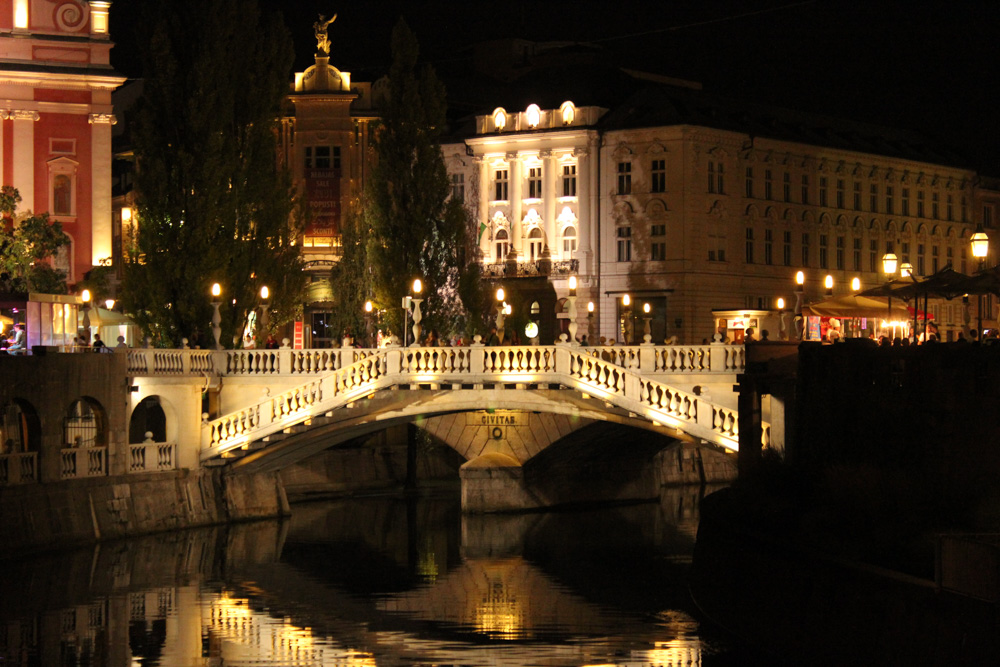
Day 6: Divača to Koper / Distance: 37 miles
On our last day, we awoke to ideal biking weather—crisp and sunny. Since we would be crisscrossing down the Italian/Slovene coastline, Sašo suggested an alternate route that would feature more natural scenery and include a beach break. We unanimously agreed and were off! During our customary midmorning break, Sašo explained that the surrounding region was primarily bilingual because this area of Slovenia had been northeastern Italy until WWII ended.
Ahead, we veered off onto a dusty, gravelly trail called the Alpe Adria Trail. The former railroad track ran along a scenic, upper ridge that skirted the Adriatic coastline. The bumpy path meandered through lush woods and dark tunnels before dazzling us with spectacular sea views and a sneak peek of Trieste, Italy. My adrenaline spiked like a double shot of espresso after turning onto a head-bobbling, cobblestoned street that spiraled sharply down to the sprawling city below. From there, we scooted along perilous stretches of highway to Trieste’s coastal outskirts and Muggia’s petite port, where we “braked” for luscious gelato at Jimmy’s. Mmmmmm.
Along Italy’s coast-hugging scenic route, we glided past shimmering turquoise ripples and topless sunbathers draped over rocks. After crossing the border back into Slovenia, vineyards and olive groves flanked our way while we ascended up what Sašo promised—for the final time—was the “last hill.” In quaint Ankaran, we turned off at a seaside campground, where everyone relaxed and enjoyed the pine tree–shaded beach. That is, except for Sašo and Oksana, who graciously insisted on driving back to retrieve my travel journal that I had accidentally left on a table—in Italy! They deserve a big “hvala” (thanks)!
During the few remaining miles, we skimmed by the gritty, industrial outskirts of Koper, which is the largest seaside port along Slovenia’s sliver of shoreline that adjoins Croatia. Once inside Koper, we discovered a delightful medieval heart and lively harbor lined with cafés and shops. Beckoning from across the street was Hotel Koper, our bittersweet finish line!
An hour later, we gathered on the hotel’s terrace for a farewell drink, which included an unexpected touch—a certificate presentation ceremony. Between rounds of Slovene sparkling wine, we autographed each other’s diplomas and took photos.
As I glanced fondly around the table at my comrades, my initial thoughts following the first night’s orientation came to mind. Assuming our language barriers would prohibit us from creating a true kinship, I had had misgivings regarding our upcoming adventure. However, seven days and several miles and hills later, I felt saddened to say good-bye to my traveling companions, who truly enhanced my amazing experiences and broadened my perspective about their respective homelands and cultures. After all, is that not why we travel?
— V —
Kim Duke-Layden is an international adventurer with insatiable wanderlust, who lives at Sandestin Golf and Beach Resort with her husband, John. In between frequent excursions, she is a Realtor® for The Premier Property Group at Grand Boulevard. For travel tips, contact her at kim@theppg.net; or www.kimsellsdestin.com
Share This Story!
KEEP UP WITH THE LATEST STORIES FROM VIE


















































































































































